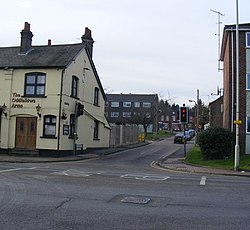Apsley, Hertfordshire
| Apsley | |
|---|---|
 Part of London Road , Apsley |
|
| Apsley shown within Hertfordshire | |
| OS grid reference | TL0505 |
| District | |
| Shire county | |
| Region | |
| Country | England |
| Sovereign state | United Kingdom |
| Post town | HEMEL HEMPSTEAD |
| Postcode district | HP3 |
| Dialling code | 01442 |
| Police | Hertfordshire |
| Fire | Hertfordshire |
| Ambulance | East of England |
| EU Parliament | East of England |
| UK Parliament | |
Apsley was a 19th-century mill village in the county of Hertfordshire, England. It is a historic industrial site situated in a valley of the Chiltern Hills. It is positioned below the confluence of two permanent rivers, the Gade and Bulbourne. In an area of little surface water this was an obvious site for the location of water mills serving local agriculture. Today it is a suburb of the larger town of Hemel Hempstead.
Recent (2011–) rapid building around the canal area has seen a large influx of London commuters, largely from the software and business communities. At the 2011 Census the village was included in the Dacorum Ward of Aspley and Corner Hall.
The name Apsley dates from the Anglo-Saxon period and means aspen wood.
It was the construction of the trunk canal (later to be called the Grand Union Canal) between London and the Midlands through the valley in 1798 that began its industrial rise at the start of the 19th century. The canal gave an easy way of transporting the raw and manufactured products to and from the mills.
John Dickinson, the inventor of a new method of continuous papermaking, purchased an existing mill in the area in 1809. There is record of paper making already taking place nearby at this time. His business expanded throughout the Victorian age coming to occupy large parts of the flat land in the valley bottom. Streets of mill workers' terraced houses grew up adjacent to the mills. Housing for managers was built on the old Manor Farm, higher up the hill towards Felden, in the grounds of the Manor Estate, today known as Shendish Manor. Production peaked during the Second World War. The site was however not ideal for large scale papermaking in the 20th century and later became a warehouse and distribution centre for products made elsewhere. The last John Dickinson warehouse closed in 1999. There is a National Paper Museum called the Paper Trail in some remaining mill buildings. Paper continued to be made until 2006 a short distance away at Nash Mills by the global Sappi group at a former John Dickinson mill. This too closed for production in 2006 but continued as a distribution centre for some time. In 2011, the Sappi site was redeveloped for canal-side housing, preserving some of the historic structures at the site.
...
Wikipedia

